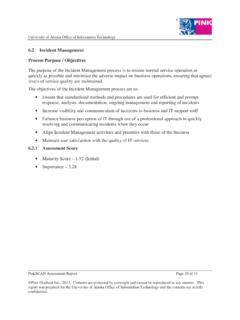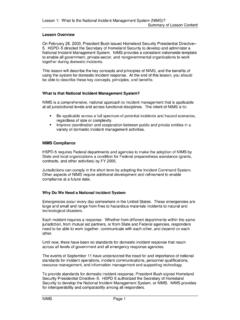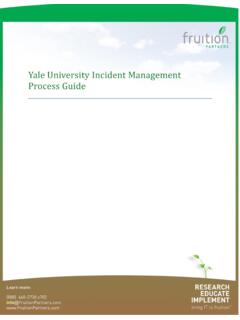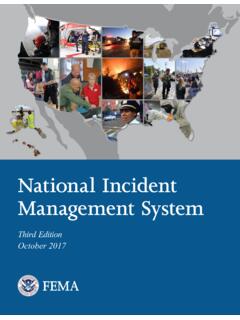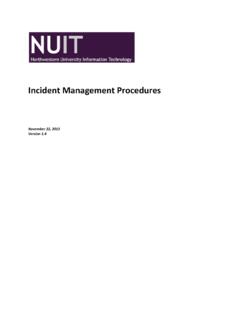Transcription of Incident Management Process Description
1 ITSM Process Description - Incident Management 1 ITSM Process Description Office of Information Technology Incident Management ITSM Process Description - Incident Management 2 Table of Contents Table of Contents 1. Introduction 2. Incident Management Goals, Objectives, CSFs and KPIs 3. Incident Management Scope General Process Scope Deployment Scope 4. Benefits Benefits To The IT Service Providers Benefits To The Users 5. Key Terms & Definitions 6. Roles & Responsibilities Incident Management Process Owner Incident Management Process Manager Tier 1 Technician Tier 2 Incident Coordinator Tier 2 Incident Technician User Incident Management High Level Process Flow Incident Management High Level Process Descriptions Incident Management Tier 1 Process Flow Incident Management Tier 1 Process Activity Descriptions Incident Management Tier 1 Process RACI Matrix Incident Management Tier 2 Process Flow Incident Management Tier 2 Process Activity Descriptions Incident Management Tier 2 Process RACI Matrix Incident Management Verify Document
2 & Close Process Flow Incident Management Verify, Document & Close (VD&C) Process Activity Descriptions Incident Management VD&C Process RACI Matrix ITSM Process Description - Incident Management 3 1. Introduction The purpose of this document is to provide a general overview of the Office of Information Technology (OIT) Incident Management Process . It includes Incident Management goals, objectives, scope, benefits, key terms, roles, responsibilities, authority, Process diagrams and associated activity descriptions. The content within this general overview is based on the best practices of the ITIL framework[1].
3 2. Incident Management Goals, Objectives, CSFs and KPIs Goals, objectives and critical success factors (CSFs) define why Incident Management is important to the Office of Information Technology s overall vision for delivering and supporting effective and efficient IT services. This section establishes the fundamental goals, objectives and CSFs that underpin the Incident Management Process . The agreed and documented goals, objectives and CSFs provide a point of reference to check implementation and operational decisions and activities. Incident Management is the Process responsible for managing the lifecycle of all Incidents irrespective of their origination.
4 The goals for the Incident Management Process are to: Restore normal service operation as quickly as possible Minimize the adverse impact on business operations Ensure that agreed levels of service quality are maintained To achieve this, the objectives of OIT s Incident Management Process are to: Ensure that standardized methods and procedures are used for efficient and prompt response, analysis, documentation, ongoing Management and reporting of Incidents Increase visibility and communication of Incidents to business and IT support staff Enhance business perception of IT through use of a professional approach in quickly resolving and communicating incidents when they occur Align Incident Management activities and priorities with those of the business Maintain user satisfaction with the quality of IT services CSFs identified for the Process of Incident Management and associated Key Performance Indicators (KPIs) are: CSF #1 - OIT commitment to the Incident Management Process .
5 All departments using the same Process . KPI - Number of self service tickets via a customer portal verses tickets created by the Service Desk. - Review metrics via ITSM tool on all Incident requests recorded and escalated within OIT. KPI - Management is known to review standardized reports produced by the Incident Management Process . ITSM Process Description - Incident Management 4 - ITSM tool, standardized/customized reports made available. KPI - Number of incidents in ITSM tool per department. - Review metrics via ITSM tool on all Incident requests recorded and escalated within OIT.
6 KPI - Management is known to be a user of the Incident Management Process . - Review metrics via ITSM tool on all Incident requests recorded and escalated within OIT. CSF #2 - Consistent, positive experience for all customers KPI - Improved assignment, response and closure time. Review metrics via ITSM tool on all Incident requests recorded and escalated within OIT specifically focusing on MTTR and customer satisfaction surveys. KPI - Customer use of self service portal increases. Review metrics via ITSM tool on all Incident requests recorded via self service portal. KPI - Amount of journal entries consistent with SLA.
7 Review metrics via ITSM tool for services with SLA specifically focusing on the quantity and quality of updates in Incident requests. KPI - number of incidents reopened. Review metrics via ITSM tool specifically looking at incidents that were reopened. CSF #3 Ability to track internal Process performance and identify trends. KPI - Process performance meets established standards in OIT Baseline SLA including: Assignment time, response time, resolution time, closure time. Review metrics via ITSM tool on all Incident requests recorded and escalated within OIT; measuring MTTR and SLA requirements.
8 KPI - Number of re-assigned tickets between departments. Review metrics via ITSM tool on all Incident requests recorded specifically looking at incidents that were reassigned. 3. Incident Management Scope Scope refers to the boundaries or extent of influence to which Incident Management applies to the Office of Information Technology. OIT s Incident Management Process consists of three sub-processes titled Tier 1, Tier 2 and Verify Document and Close (VD&C). The Tier 1 sub- Process is initiated by any department dealing directly with the user and able to resolve the Incident without involving additional departments.
9 The Tier 2 sub- Process is initiated when an Incident requires multiple departments to resolve an Incident . The VD&C sub- Process provides a consistent experience for the user ensuring high levels of customer service. Although it is an optional Process , it is considered best practice for departments to adhere to. Boundaries for the extent of deployment within the Office of Information Technology are identified for users, service providers, geography, IT services and service components and environment. ITSM Process Description - Incident Management 5 General Process Scope Any event which disrupts, or which could disrupt, a service, including those: Reported directly by users Reported and/or logged by technical staff Detected by Event Management Reported and/or logged by Suppliers Incident Management encompasses all IT service providers, internal and third parties, reporting, recording or working on an Incident .
10 All Incident Management activities should be implemented in full, operated as implemented, measured and improved as necessary. Deployment Scope Incident Management will be deployed and applicable to: Users covered by Service Level Agreements (SLAs) specifying service targets for resolution of Incidents Service Providers adopting the Incident Management responsibilities outlined by Service Level Agreements, Operating Level Agreements (OLAs), and Underpinning Contracts (UCs) Services to which Incident Management Resolution Targets agreed in Service Level Agreements apply 4. Benefits There are several qualitative and quantitative benefits that can be achieved, for both the IT service providers and users, by implementing an effective and efficient Incident Management Process .
